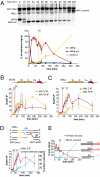Real-time analysis of double-strand DNA break repair by homologous recombination
- PMID: 21292986
- PMCID: PMC3044406
- DOI: 10.1073/pnas.1019660108
Real-time analysis of double-strand DNA break repair by homologous recombination
Abstract
The ability to induce synchronously a single site-specific double-strand break (DSB) in a budding yeast chromosome has made it possible to monitor the kinetics and genetic requirements of many molecular steps during DSB repair. Special attention has been paid to the switching of mating-type genes in Saccharomyces cerevisiae, a process initiated by the HO endonuclease by cleaving the MAT locus. A DSB in MATa is repaired by homologous recombination--specifically, by gene conversion--using a heterochromatic donor, HMLα. Repair results in the replacement of the a-specific sequences (Ya) by Yα and switching from MATa to MATα. We report that MAT switching requires the DNA replication factor Dpb11, although it does not require the Cdc7-Dbf4 kinase or the Mcm and Cdc45 helicase components. Using Southern blot, PCR, and ChIP analysis of samples collected every 10 min, we extend previous studies of this process to identify the times for the loading of Rad51 recombinase protein onto the DSB ends at MAT, the subsequent strand invasion by the Rad51 nucleoprotein filament into the donor sequences, the initiation of new DNA synthesis, and the removal of the nonhomologous Y sequences. In addition we report evidence for the transient displacement of well-positioned nucleosomes in the HML donor locus during strand invasion.
Conflict of interest statement
The authors declare no conflict of interest.
Figures






Similar articles
-
A single Ho-induced double-strand break at the MAT locus is lethal in Candida glabrata.PLoS Genet. 2020 Oct 15;16(10):e1008627. doi: 10.1371/journal.pgen.1008627. eCollection 2020 Oct. PLoS Genet. 2020. PMID: 33057400 Free PMC article.
-
Regulation of budding yeast mating-type switching donor preference by the FHA domain of Fkh1.PLoS Genet. 2012;8(4):e1002630. doi: 10.1371/journal.pgen.1002630. Epub 2012 Apr 5. PLoS Genet. 2012. PMID: 22496671 Free PMC article.
-
In vivo roles of Rad52, Rad54, and Rad55 proteins in Rad51-mediated recombination.Mol Cell. 2003 Jul;12(1):209-19. doi: 10.1016/s1097-2765(03)00269-7. Mol Cell. 2003. PMID: 12887906
-
A Life Investigating Pathways That Repair Broken Chromosomes.Annu Rev Genet. 2016 Nov 23;50:1-28. doi: 10.1146/annurev-genet-120215-035043. Epub 2016 Oct 3. Annu Rev Genet. 2016. PMID: 27732795 Review.
-
Mating-type Gene Switching in Saccharomyces cerevisiae.Microbiol Spectr. 2015 Apr;3(2):MDNA3-0013-2014. doi: 10.1128/microbiolspec.MDNA3-0013-2014. Microbiol Spectr. 2015. PMID: 26104712 Review.
Cited by
-
Rdh54/Tid1 inhibits Rad51-Rad54-mediated D-loop formation and limits D-loop length.Elife. 2020 Nov 13;9:e59112. doi: 10.7554/eLife.59112. Elife. 2020. PMID: 33185188 Free PMC article.
-
CDC7-dependent transcriptional regulation of RAD54L is essential for tumorigenicity and radio-resistance of glioblastoma.Transl Oncol. 2018 Apr;11(2):300-306. doi: 10.1016/j.tranon.2018.01.003. Epub 2018 Feb 4. Transl Oncol. 2018. PMID: 29413763 Free PMC article.
-
Frequent Interchromosomal Template Switches during Gene Conversion in S. cerevisiae.Mol Cell. 2014 Aug 21;55(4):615-25. doi: 10.1016/j.molcel.2014.06.025. Epub 2014 Jul 24. Mol Cell. 2014. PMID: 25066232 Free PMC article.
-
Rad51-mediated double-strand break repair and mismatch correction of divergent substrates.Nature. 2017 Apr 20;544(7650):377-380. doi: 10.1038/nature22046. Epub 2017 Apr 12. Nature. 2017. PMID: 28405019 Free PMC article.
-
Understanding the origins of UV-induced recombination through manipulation of sister chromatid cohesion.Cell Cycle. 2012 Nov 1;11(21):3937-44. doi: 10.4161/cc.21945. Epub 2012 Sep 17. Cell Cycle. 2012. PMID: 22987150 Free PMC article.
References
Publication types
MeSH terms
Substances
Grants and funding
LinkOut - more resources
Full Text Sources
Other Literature Sources
Molecular Biology Databases
Research Materials

